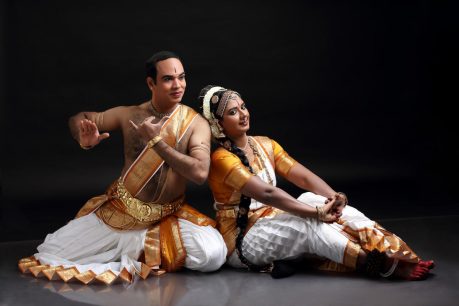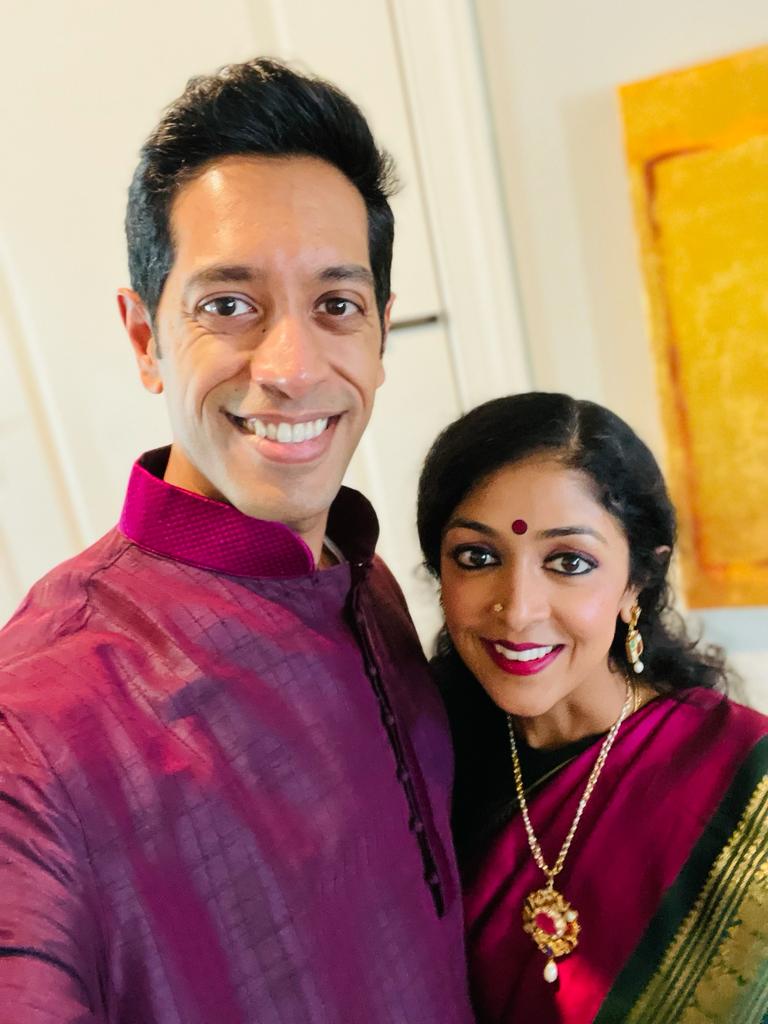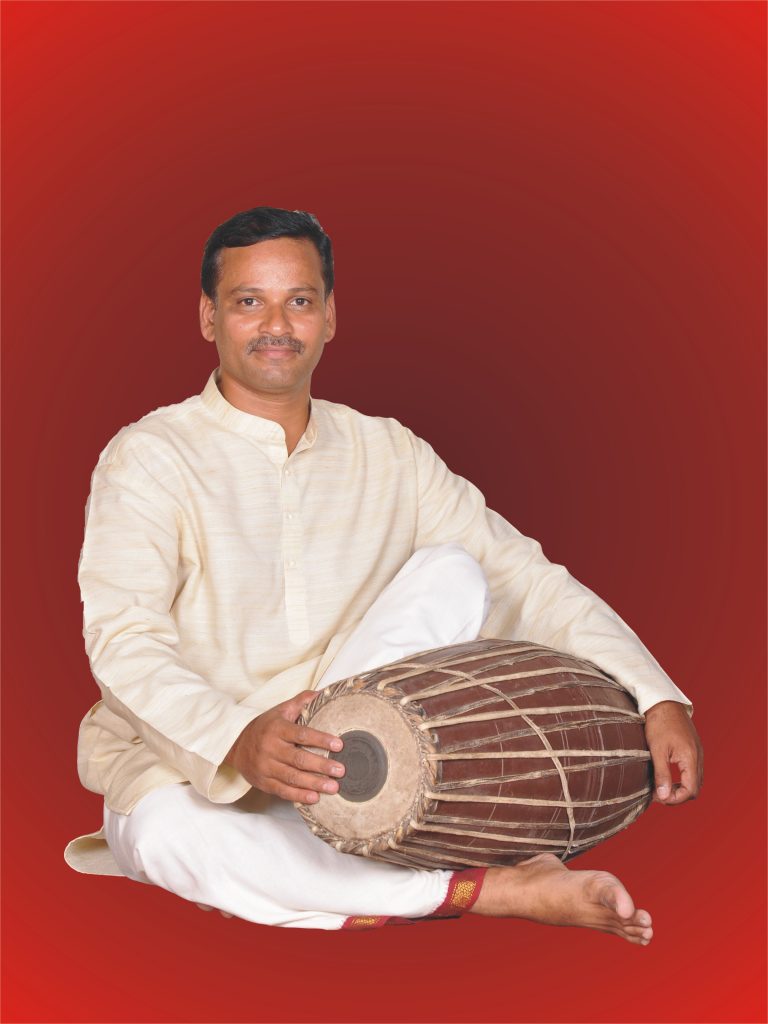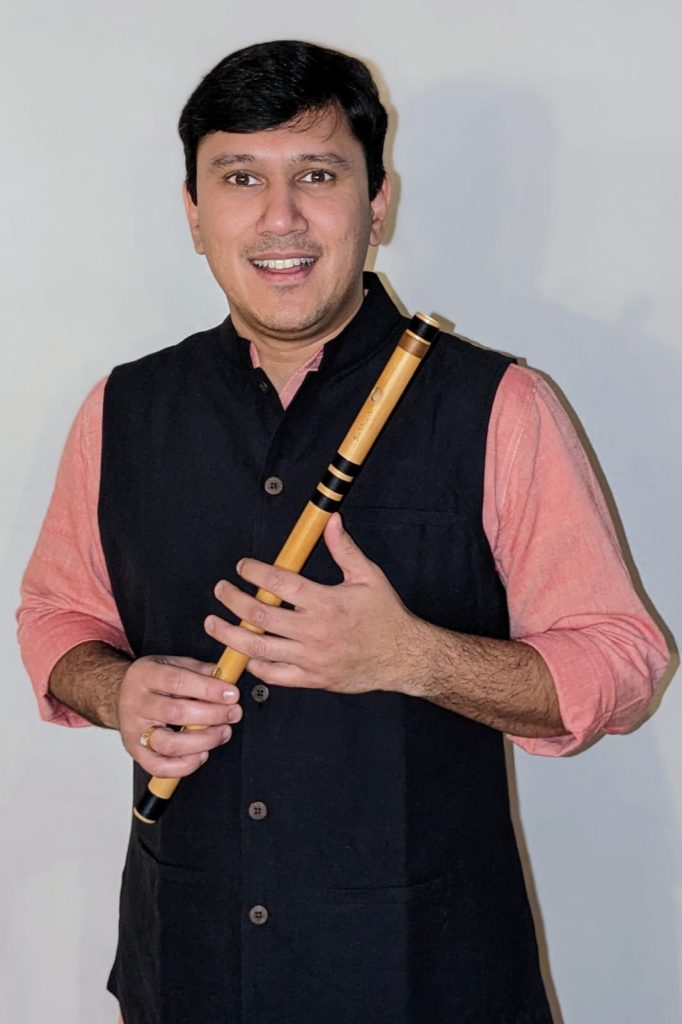Your cart is currently empty!

Kuchipudi Dance Performance
By Jaikishore and Padmavani Mosalikanti
Saturday, September 30, 2023 | 4:30 PM EDT
Bryn Mawr College
Goodhart Hall, 101 N Merion Ave, Bryn Mawr, PA 19010
About This Event
SRUTI is pleased to present a Grand Kuchipudi dance performance by Jaikishore and Padmavani Mosalikanti Kuchipudi Dance
Jaikishore and Padmavani Mosalikanti – Dancers
Jaikishore and Padmavani are an internationally acclaimed Kuchipudi dance duo from India and leading exponents of this art form. They are direct disciples of Sri Vempati Chinna Satyam, one of the stalwarts who stylized and popularized it worldwide. Sri. Jaikishore has rapidly emerged as an accomplished dancer with an uncanny understanding of the nuances of the art. His technical perfection, flexibility, and complete transformation into the character he depicts have won him admirable accolades along the globe. Smt. Padmavani, wife and disciple of Sri. Jaikishore, was initiated into dance at a very young age and has eventually grown to be a Kuchipudi exponent. She is a guru who can speak in the language of the young and impart the knowledge of Kuchipudi dance, philosophy, spirituality and art with great compassion and connection.
The duo have been traveling worldwide enthralling audiences with spectacular performances, Masterclasses and workshops.
Taniya Panda – Vocal
Taniya began her training in the Carnatic style of Indian classical music in Toronto, Canada from Smt. Vijayalakshmi Seenivasagam. In her early teens, she moved to Chennai, India to undergo more intensive training from the acclaimed ‘Veena Vidushi’, Smt. Padmavathy Ananthagopalan. Taniya is also an accomplished Bharatanatyam dancer having undergone training with Guru A. Lakshmanaswamy. She has performed solo, duet and group productions in India, Canada and the US both as a dancer and supporting vocalist.
Taniya is currently continuing her vocal training with Kyvalya Chilla of Secunderabad. She is presently based in Marietta, Ga where she runs behind her two children. And when she isn’t singing or running in circles, she performs Bharatanatyam duets with her husband!

Puneet Panda – Nattuvangam
With a classical, creative, and sincere approach to his craft, Puneet Panda is a vibrant performer with an effervescent joy for the inner realm of Bharatanatyam. He has performed extensively in India and the US. Critics have applauded his rare combination of energy and elegance while staying true to the tradition-bound purity of his Gurus, the Dhananjayans. Puneet is a deft nattuvanar and has accompanied many accomplished dancers.
Puneet is a board certified ophthalmologist practicing in the Atlanta area. When he isn’t performing eye surgery, he performs Bharatanatyam with his wife!
B.P. Haribabu – Mridangam
A versatile Mridangam exponent trained under the guidance of exemplary gurus ‘Kalaimamani’ Sri. V.P. Ramadoss and ‘Sangeetha Kalanidhi” Sri. Thiruvarur Bhakthavatsalam, Haribabu has carved a niche for himself in the dance world. He acquired the skill from such stalwarts at the Tamil Nadu Govt. Music College. He was conferred the title ‘Vaadhya Visharadha’ in 1988 recognizing his adeptness in the art form. Besides being an expert Mridangam artist, he is equally proficient in Pakhawaj, Nattuvangam and Rhythm composing. He, being a specialist in playing for the Bharatanatyam and Kuchipudi concerts, is the most sought after Mridangam artiste for at least 3 decades. He had been teaching and conducting workshops, lecture- demonstrations on Nattuvangam and rhythm for dancers and dance teachers. A Globe-trotter who has major countries across the globe amounting to 34 countries and 106 international tours, this is the 52nd USA tour. He also has to his credit of working with major Dance companies in the USA. He has performed twice at the prestigious John F. Kennedy Center, Fall for Dance Festival in NYC, and Jacob’s Pillow Dance Festival in Becket, MA.

Sai Kishore Ravisankar – Flute
Sai Kishore Ravisankar is a classically trained flutist from Trichy, Tamil Nadu. He started learning flute at a very young age under the tutelage of Trichy J. Venkatraman. Sai has performed on various Indian Television channels, All India Radio and across several stages in India & USA. He continues to accompany several eminent Indian musicians such as K.J. Yesudas and K.S. Chitra to name a few. He is a recipient of numerous awards and accolades. Sai is a Mechanical design engineer and lives in ATL, GA.

Dance Review
Mesmerizing Kuchipudi Recital Enthralls Audiences
By Madhavi Ratnagiri
Over the years Sruti has organized many a dance performance by eminent artists in the field, each one of which I have deeply enjoyed and treasured. However, the performance on September 30th by Sri. Jaikishore and Smt. Padmavani Mosalikanti was particularly special for me. With its focus on Kuchipudi’s classical foundations, it felt close to my heart. The program thoughtfully highlighted Kuchipudi’s classical roots and Telugu heritage. This was evident in the repertoire with compositions by legendary Telugu composers like Thyagaraja, Annamacharya and Padma Bhushan Dr. Balamurali Krishna. Every choice celebrated Kuchipudi’s lineage. I was profoundly moved by this tribute to the classical core of my beloved art form.
What does Kuchipudi signify? Ask a layman and they will tell you it is the dance on a brass plate, but it is so much more. It is a classical dance form rooted in the principles of the Natyashastra, encompassing elements of drama, rhythmic footwork and elegant movements. It is vivacious, fast-paced and despite its vibrant nature, I have often pondered why Kuchipudi is not widely embraced by the general public. On that particular day, I finally found the answer to my question.
The show opened with the legendary Dr. Balamurali Krishna’s exhilarating composition “Pari Pari Nee PaadaMe” in raga Hamsadhwani and set to Adi taal. This dynamic piece set the vibrant tone for the evening. The choreography was filled with captivating footwork and elegant movements which the couple performed with flawless unison and precision. Their presentation brimmed with the exuberance and vitality that epitomizes Kuchipudi’s energetic essence.
Next in line was Sri. Jaikishore’s captivating solo performance of Guru Vempati Chinna Satyam’s iconic masterpiece, “Ksheera Saagara Sayana,” a composition by Saint Thyagaraja in ragam Devagandhari and Adi Talam. Just as this gem of a composition gives a singer the scope to showcase their competency, Vempati mastergaru’s thoughtful open-ended choreography gives tremendous scope for the dancer to showcase their prowess with abhinaya and storytelling. And that is precisely what Kishore accomplished with his masterful presentation. As he stepped onto the stage, it felt as though he was holding a lamp, evoking the image of Thyagaraja entering his prayer room at the break of dawn. As Kishore took his seat, the audience could sense the impending agony and profound emotions that Thyagaraja likely experienced before penning this piece.
The dance performance incorporated various sancharis, which are expressive elements used to convey the essence of the lyrics through descriptive illustrations of scenes or stories. The first sanchari depicted the episode of Gajendra Moksha, where Gajendra the king of the elephants is attacked by a crocodile. While I have witnessed this portrayal numerous times, it was during this performance that I truly witnessed the slew of emotions Gajendra might have experienced while grappling with this formidable adversary. I could see the shock, confusion, terror and desperation which enabled me to envision Gajendra’s state of mind when trapped by the crocodile.
This was only the tip of the iceberg as the performance delved into many other captivating scenes. The scene of Draupadi vastrapaharanam is a complex situation involving multiple characters, including the malicious Duryodhana, the wise Yudhistra, the reckless Dushasana, the cunning Shakuni, and the hapless Draupadi. Portraying each character and seamlessly transitioning between them is a challenge even for the most seasoned dancers, but Kishore executed it with artistry. When he transformed into the character of Shakuni and walked with a limp across the stage, the audience couldn’t help but express their awe. It was evident that Kishore had captivated the undivided attention of the audience. I also admired his subtle approach in depicting the feminine role and conveying the profound helplessness of Draupadi.
In another segment of the performance, Kishore depicted a scene from the Ramayana where Sita is abducted by Ravana. He skillfully portrayed Ravana’s cunning disguise as a sage to entice Sita into crossing the Lakshmana Rekha. In this scene Kishore intentionally forgets to alter Ravana’s natural aristocratic walk to that of a mendicant’s humble gait, adding a subtle touch of humor to an otherwise serious and intense scene. This creative element included by the choreographer showcased his imaginative approach in infusing light-heartedness into a somber moment. There were numerous such subtle nuances throughout the performance that could be discussed at length. Overall, it was a deeply moving portrayal that was truly a visual delight for the audience.
The solemn and theatrical portrayal was followed by a contrasting cheerful, lively dance – What better way to showcase the versatility of Kuchipudi and its ability to be adapted both to serious, stylized performances as well as lighthearted, casual portrayals. Smt. Padmavani Mosalikanti followed up with the Annamacharya kriti, “Palluku thenala Thalli”, in ragam Aabheri and Adi talam, portraying the shyness and grace of goddess Padmavathi. She portrayed the coyness and the daintiness of the goddess with dexterity. Her expressive eyes darting amorously and the lovesick sideways glance when speaking of her lord will forever be etched in my memory. Her tender, flirtatious glances embodied Padmavathi’s devoted adoration.
After the wonderful performances so far had whet our appetite, then came the highlight of the evening’s performance, Durga Tarangam. This piece truly showcased the essence of Kuchipudi. Kishore’s vibrant choreography elevated the traditional tarangam into an unforgettable dramatic experience, exemplifying Kuchipudi’s storytelling aspect.
The scene of Durga receiving weapons from the gods was a visual delight, nicely symbolizing her preparation for battle. Smt. Padmavani portrayed Durga with skill, effortlessly showing the goddess’s compassion for her devotees as well as her fierce aggression towards the demon Mahisha. The fight between Durga and Mahisha looked so vivid and spontaneous. When Durga kicked the demon, sending Kishore dramatically falling backwards, it was a breathtaking, stunning moment. Beyond the organic, beautiful choreography, their meticulous attention to detail made the performance unforgettable. The piece concluded with the crowd-pleasing traditional dance on a brass plate, performed with dynamism and energy.
The couple ended the recital with a Thillana, in ragam Behag, set to Adi Talam, another composition by Dr. M. Balamurali Krishna. The duo displayed their mastery over intricate footwork, executed swift turns and leaps with agility and grace. The complex rhythms on the mridangam and nattuvangam intertwined seamlessly with the dancers’ movements. Their energy resonated, bringing the atmosphere to a dynamic crescendo. It was a triumphant grand finale to the exhilarating show.
The dancers were accompanied by a talented team of musicians – Sri. Puneeth Panda on nattuvangam, Smt. Tanya Panda on vocals, Sri. Sai Kishore on flute, and Sri. B.P. Haribabu on mridangam and Ananda Krishna on the violin. Puneeth and Tanya Panda made a skilled duo, with her vocal mastery and his rhythmic nattuvangam. Sai Kishore’s flute provided melodic flourishes; Ananda Krishna illuminated with his violin while Haribabu was scintillating on mridangam. These accomplished musicians provided the perfect complementary accompaniment to the dancers. Their collaboration truly enhanced the overall performance. Further, the lighting effects created an ambient atmosphere that nicely augmented the performance.
Even weeks later, everyone I spoke with raved about how enjoyable the entire performance was. It truly showed how Kuchipudi can captivate audiences when presented by the right ambassadors. The overwhelming positive response proved this style can absolutely gain mainstream popularity as well as the appreciation of the dance connoisseurs through charismatic performers. Based on the enthusiastic reactions still evident long afterwards, this event demonstrated Kuchipudi has the power to delight people when shared by dedicated virtuosos.
I have known Sri. Jaikishore Mosalikanti since our childhood days studying under our guru. Over time, my respect and admiration for him has only grown. He not only embodies our master’s style in technique and execution, but also continues his choreographic legacy. As students of Vempati Chinna Satyam, Jaikishore and Padmavani stay true to our guru’s classical foundations while also innovating and advancing the art form.
My heart brims with pride that the Mosalikantis are the torch bearers of Kuchipudi and promote its beauty and authenticity with sincerity and dedication.
Madhavi Ratnagiri is a talented exponent of the classical Indian dance styles Kuchipudi and Bharatnatyam. She was trained in Kuchipudi under the eminent guru Padma Bhushan Dr.Vempati Chinna Satyam and learned Bharatnatyam from the distinguished Padma Bhushan Dr.Padma Subrahmanyam. Through her dance school Kalaananda, Madhavi passes on the rich tradition of Kuchipudi to the next generation of aspiring dancers, inspiring them with her artistry and passion.

